
Galileo was an American robotic space program that studied the planet Jupiter and its moons, as well as several other Solar System bodies. Named after the Italian astronomer Galileo Galilei, the Galileo spacecraft consisted of an orbiter and an atmospheric entry probe. It was delivered into Earth orbit on October 18, 1989, by Space ShuttleAtlantis on the STS-34 mission, and arrived at Jupiter on December 7, 1995, after gravity assist flybys of Venus and Earth, and became the first spacecraft to orbit Jupiter. The spacecraft then launched the first probe to directly measure its atmosphere. Despite suffering major antenna problems, Galileo achieved the first asteroid flyby, of 951 Gaspra, and discovered the first asteroid moon, Dactyl, around 243 Ida. In 1994, Galileo observed Comet Shoemaker–Levy 9's collision with Jupiter.

Spacecraft propulsion is any method used to accelerate spacecraft and artificial satellites. In-space propulsion exclusively deals with propulsion systems used in the vacuum of space and should not be confused with space launch or atmospheric entry.

The solar wind is a stream of charged particles released from the upper atmosphere of the Sun, called the corona. This plasma mostly consists of electrons, protons and alpha particles with kinetic energy between 0.5 and 10 keV. The composition of the solar wind plasma also includes a mixture of materials found in the solar plasma: trace amounts of heavy ions and atomic nuclei of elements such as carbon, nitrogen, oxygen, neon, magnesium, silicon, sulfur, and iron. There are also rarer traces of some other nuclei and isotopes such as phosphorus, titanium, chromium, and nickel's isotopes 58Ni, 60Ni, and 62Ni. Superimposed with the solar-wind plasma is the interplanetary magnetic field. The solar wind varies in density, temperature and speed over time and over solar latitude and longitude. Its particles can escape the Sun's gravity because of their high energy resulting from the high temperature of the corona, which in turn is a result of the coronal magnetic field. The boundary separating the corona from the solar wind is called the Alfvén surface.

An ion thruster, ion drive, or ion engine is a form of electric propulsion used for spacecraft propulsion. An ion thruster creates a cloud of positive ions from a neutral gas by ionizing it to extract some electrons from its atoms. The ions are then accelerated using electricity to create thrust. Ion thrusters are categorized as either electrostatic or electromagnetic.

Spaceflight is an application of astronautics to fly objects, usually spacecraft, into or through outer space, either with or without humans on board. Most spaceflight is uncrewed and conducted mainly with spacecraft such as satellites in orbit around Earth, but also includes space probes for flights beyond Earth orbit. Such spaceflight operate either by telerobotic or autonomous control. The more complex human spaceflight has been pursued soon after the first orbital satellites and has reached the Moon and permanent human presence in space around Earth, particularly with the use of space stations. Human spaceflight programs include the Soyuz, Shenzhou, the past Apollo Moon landing and the Space Shuttle programs. Other current spaceflight are conducted to the International Space Station and to China's Tiangong Space Station.

Space weather is a branch of space physics and aeronomy, or heliophysics, concerned with the varying conditions within the Solar System and its heliosphere. This includes the effects of the solar wind, especially on the Earth's magnetosphere, ionosphere, thermosphere, and exosphere. Though physically distinct, space weather is analogous to the terrestrial weather of Earth's atmosphere. The term "space weather" was first used in the 1950s and popularized in the 1990s. Later, it prompted research into "space climate", the large-scale and long-term patterns of space weather.
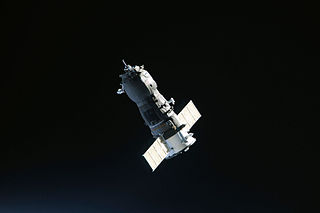
Uncrewed spacecraft or robotic spacecraft are spacecraft without people on board. Uncrewed spacecraft may have varying levels of autonomy from human input, such as remote control, or remote guidance. They may also be autonomous, in which they have a pre-programmed list of operations that will be executed unless otherwise instructed. A robotic spacecraft for scientific measurements is often called a space probe or space observatory.
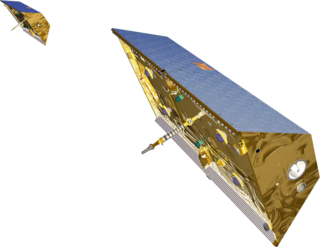
The Gravity Recovery and Climate Experiment (GRACE) was a joint mission of NASA and the German Aerospace Center (DLR). Twin satellites took detailed measurements of Earth's gravity field anomalies from its launch in March 2002 to the end of its science mission in October 2017. The two satellites were sometimes called Tom and Jerry, a nod to the famous cartoon. The GRACE Follow-On (GRACE-FO) is a continuation of the mission on near-identical hardware, launched in May 2018. On March 19, 2024, NASA announced that the successor to GRACE-FO would be Gravity Recovery and Climate Experiment-Continuity (GRACE-C), to be launched in or after 2028.

Satellite geodesy is geodesy by means of artificial satellites—the measurement of the form and dimensions of Earth, the location of objects on its surface and the figure of the Earth's gravity field by means of artificial satellite techniques. It belongs to the broader field of space geodesy. Traditional astronomical geodesy is not commonly considered a part of satellite geodesy, although there is considerable overlap between the techniques.

Time History of Events and Macroscale Interactions during Substorms (THEMIS) mission began in February 2007 as a constellation of five NASA satellites to study energy releases from Earth's magnetosphere known as substorms, magnetic phenomena that intensify auroras near Earth's poles. The name of the mission is an acronym alluding to the Titan Themis.

Spacecraft electric propulsion is a type of spacecraft propulsion technique that uses electrostatic or electromagnetic fields to accelerate mass to high speed and thus generating thrust to modify the velocity of a spacecraft in orbit. The propulsion system is controlled by power electronics.
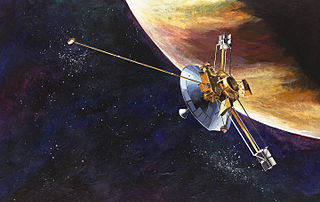
The exploration of Jupiter has been conducted via close observations by automated spacecraft. It began with the arrival of Pioneer 10 into the Jovian system in 1973, and, as of 2023, has continued with eight further spacecraft missions in the vicinity of Jupiter. All of these missions were undertaken by the National Aeronautics and Space Administration (NASA), and all but two were flybys taking detailed observations without landing or entering orbit. These probes make Jupiter the most visited of the Solar System's outer planets as all missions to the outer Solar System have used Jupiter flybys. On 5 July 2016, spacecraft Juno arrived and entered the planet's orbit—the second craft ever to do so. Sending a craft to Jupiter is difficult, mostly due to large fuel requirements and the effects of the planet's harsh radiation environment.

In geophysics, a magnetic anomaly is a local variation in the Earth's magnetic field resulting from variations in the chemistry or magnetism of the rocks. Mapping of variation over an area is valuable in detecting structures obscured by overlying material. The magnetic variation in successive bands of ocean floor parallel with mid-ocean ridges was important evidence for seafloor spreading, a concept central to the theory of plate tectonics.
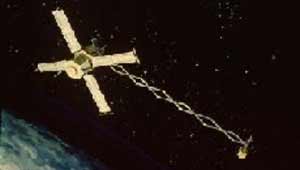
Magsat was a NASA/USGS spacecraft, launched on 30 October 1979. The mission was to map the Earth's magnetic field, the satellite had two magnetometers. The scalar and vector magnetometers gave Magsat a capability beyond that of any previous spacecraft. Extended by a telescoping boom, the magnetometers were distanced from the magnetic field created by the satellite and its electronics. The satellite carried two magnetometers, a three-axis fluxgate magnetometer for determining the strength and direction of magnetic fields, and an ion-vapor/vector magnetometer for determining the magnetic field caused by the vector magnetometer itself. Magsat is considered to be one of the more important Science/Earth orbiting satellites launched; the data it accumulated is still being used, particularly in linking new satellite data to past observations.

Aditya-L1 (/aːd̪it̪jə/) is a coronagraphy spacecraft for studying the solar atmosphere, designed and developed by the Indian Space Research Organisation (ISRO) and various other Indian Space Research Institutes. It is orbiting at about 1.5 million km from Earth in a halo orbit around the Lagrange point 1 (L1) between the Earth and the Sun, where it will study the solar atmosphere, solar magnetic storms, and their impact on the environment around the Earth.

Soil Moisture Active Passive (SMAP) is a NASA environmental monitoring satellite that measures soil moisture across the planet. It is designed to collect a global 'snapshot' of soil moisture every 2 to 3 days. With this frequency, changes from specific storms can be measured while also assessing impacts across seasons of the year. SMAP was launched on 31 January 2015. It was one of the first Earth observation satellites developed by NASA in response to the National Research Council's Decadal Survey.

The Deep Space Atomic Clock (DSAC) was a miniaturized, ultra-precise mercury-ion atomic clock for precise radio navigation in deep space. DSAC was designed to be orders of magnitude more stable than existing navigation clocks, with a drift of no more than 1 nanosecond in 10 days. It is expected that a DSAC would incur no more than 1 microsecond of error in 10 years of operations. Data from DSAC is expected to improve the precision of deep space navigation, and enable more efficient use of tracking networks. The project was managed by NASA's Jet Propulsion Laboratory and it was deployed as part of the U.S. Air Force's Space Test Program 2 (STP-2) mission aboard a SpaceX Falcon Heavy rocket on 25 June 2019.

ArgoMoon is a CubeSat that was launched into a heliocentric orbit on Artemis 1, the maiden flight of the Space Launch System, on 16 November 2022 at 06:47:44 UTC. The objective of the ArgoMoon spacecraft is to take detailed images of the Interim Cryogenic Propulsion Stage following Orion separation, an operation that will demonstrate the ability of a cubesat to conduct precise proximity maneuvers in deep space. ASI has not confirmed nor denied whether this took place, but several images of the Earth and the Moon were taken.

Tandem Reconnection and Cusp Electrodynamics Reconnaissance Satellites (TRACERS) is a planned orbiter mission tasked to study the origins of the solar wind and how it affects Earth. TRACERS was proposed by Craig A. Kletzing at the University of Iowa who served as Principal Investigator until his death in 2023. David M. Miles at the University of Iowa was named as Principal Investigator in his stead. The TRACERS mission received US$115 million in funding from NASA.
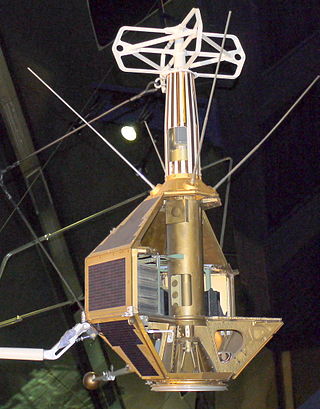
FR-1 was the second French satellite. Planned as the first French satellite, it was launched on 6 December 1965—ten days after the actual first French satellite, Astérix—by an American Scout X-4 rocket from the Western Range at Vandenberg Air Force Base. The scientific satellite studied the composition and structure of the ionosphere, plasmasphere, and magnetosphere by measuring the propagation of very low frequency (VLF) waves and the electron density of plasma in those portions of the Earth's atmosphere. FR-1's VLF receiver operated until 26 August 1968. FR-1 remains in orbit as of 2023.




















